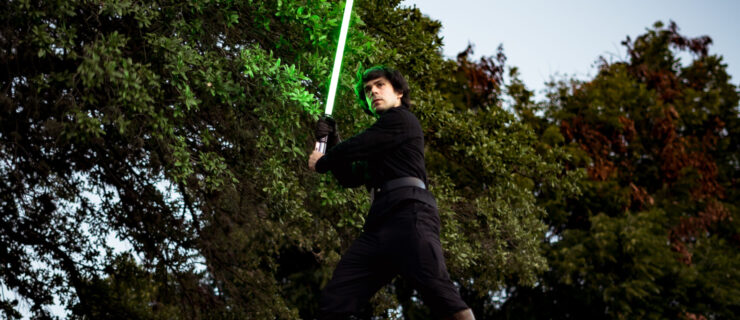A Budding Designer’s Dream Come True: Creating a Custom Tutu for Yasmine Naghdi
As a child Jenna Anderson watched Pacific Northwest Ballet’s The Nutcracker on PBS every Christmas, shushing everyone around her when the dancers came onscreen. Barred from dancing herself due to her conservative upbringing, she fueled her ballet obsession by researching first position and looking at pictures in every dance book she could find in her local library.
Many years later, Anderson decided she wanted to work in the ballet world by supporting others behind the scenes. After discovering a tutu-making course in California, she trained as a costume designer, completing internships in her home state and Chicago before heading to Winston-Salem to complete a degree at University of North Carolina School of the Arts.

Then, the pandemic hit. “COVID lit a fire within me. I wanted to pursue everything I could while I’m still here,” says Anderson. She reached out via Instagram to Royal Ballet principal Yasmine Naghdi to ask if she could make her a tutu and matching headpiece. “I’ve admired Yasmine for so long. I’ve been rooting for her since day one,” she says. “I’ve watched her on YouTube and read every article about her.”
Though Anderson never imagined her plan would come to fruition, Naghdi responded a couple of hours later accepting the offer. “I’ve never had a ballet costume made for me from scratch, so I was really excited to have a custom tutu that I could keep,” says the Royal Ballet star.
In the ensuing months the pair called frequently to exchange ideas. “I asked Jenna for a tutu that could be two costumes in one: Black Swan and Kitri,” says Naghdi. “I’ve had some wonderful requests to dance abroad this year. I’ve performed in Belgium, Dubai and France, and I have plans to dance in Japan, Seoul, Denmark and Australia. I thought a versatile tutu would be perfect as my gala baby.”

To fulfill this unconventional request, Anderson had to figure out the best way to attach interchangeable embellishments—such as the tutu plate and bodice decorations—to a black base so it can be easily transformed. “Everything has to be very secure,” says Anderson. “Especially with partnering and sweat, you have to make sure nothing’s going to get caught or fall off.” Her solution was to use buttonhole elastic.
Without any set plans, other than this initial concept, Anderson flew to London in March—her first time outside of the U.S.—hoping to be inspired by Naghdi and her surroundings. “When we had our first fitting, I could see the spark in Yasmine’s eye when she liked something,” Anderson says. “Until moments like that, it’s just another tutu. I don’t want that. I want it to be an embodiment of Yasmine’s energy, personality and body.”
Designing, making and fitting Naghdi’s tutu was be a long process. “Professionals at the Royal Opera House take around 40 hours,” Anderson explains. “Multiple people work on one product. I’m a singular person, so it will take me longer no matter what.” She estimates the tutu—which she had to complete before she left London on April 22—took around 150 to 200 hours to construct.

Throughout the project, Anderson was mentored by Anna Maria Genuisea, who runs Tutu Maker Studio and works frequently with Royal Ballet principal Marianela Nuñez. “Anna and I have a similar enthusiasm about the dancers that we get to work with,” says Anderson, “so I thought she would be willing to guide me through this journey.”
There were challenges along the way. Before she connected with Genuisea, Anderson received an unfriendly rejection from one tutu-maker she approached, who questioned her training. “Tutu-making isn’t a warm, fuzzy field,” Anderson says. “A lot of people want to protect their legacies, which I understand.”

She also struggled with imposter syndrome. “My goal was to do something like this at some point in my life and I’m doing it before I even graduate. It’s overwhelming.”
Finances have been another hurdle, especially for fine, high-quality materials. “Duchess satin is £99 per meter,” she says. “It’s very expensive, but Yasmine deserves to understand that she’s valued. Dancers hardly ever value themselves as much as they should.” To cover these expenses, she received a grant from UNCSA, as well as generous support from her hometown in California and through crowdfunding.
Anderson has learned a lot from this experience. “I’ve realized that the creative process is not as much of a burden as I was making it out to be,” she says. “Artists understand artists. Yasmine knows that this is going to involve trial and error.” She has also discovered that London is friendlier than she imagined. “I’ve experienced nothing but warmth and openness since I’ve been here.”

Going forward, Anderson hopes to work on more-collaborative projects through her new creative agency, Jenna Sais Quoi. She’s especially interested in collaborating with dancers with unique bodies and personalities who have been shunned by traditional society. “This project has legitimized my business. Now people are invested in seeing what else I can do.”






